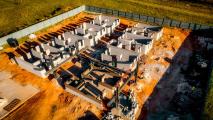For most people who experience homelessness, the situation is temporary — they might lose their job unexpectedly and find themselves on the street for a spell before landing a new one.
Chronic homelessness is a different beast. It’s recurrent or long-lasting, and the people who experience it also have a documented disability, such as a drug addiction or serious mental illness.
Those disabilities can make it particularly hard for people experiencing chronic homelessness to break the cycle — they might have more trouble finding work or accessing resources that could help them get back on their feet.
Now, Bakersfield, California, has effectively ended its chronic homelessness as part of a nationwide initiative called Built for Zero. The key to the initiative’s success, according to proponents, is real-time data.
Combating Chronic Homelessness
Data is king when it comes to battling homelessness — but it’s also hard to come by.
Knowing the current size of the homeless population and its specific needs can let a community know how best to help them: more housing, for example, or more social workers trained to help people with alcoholism.
But despite the fact that a community’s homeless population can change daily, this data collection often happens infrequently. A city might conduct what’s called a “Point-in-Time (PIT) count,” tallying the total number of people living on its streets, just once a year.
Not only could that count be inaccurate within days, it also doesn’t reveal much insight into how many people in a community are experiencing chronic homelessness or what should be done to help each particular individual.
A Way to End Homelessness
Built for Zero helps communities collect real-time data on their homeless populations and then use that data to combat chronic homelessness.
More than 80 communities are currently working with the initiative, and the first step for each is creating what Built for Zero calls a “command center.” This is all the different local agencies working to end homelessness.
The next step is creating a “by-name list” that features every person experiencing chronic homelessness in the community, as well as any available data on each individual.
The goal is to keep this list as up-to-date as possible, noting every time a new person joins it or someone leaves it, either because they moved into permanent housing or no one in the group has had contact with them in more than 60 days.
Armed with that constantly updated list, the people working at the agencies can target their available resources. They can also quickly determine whether innovative ideas to end homelessness are working or should be abandoned in favor of trying something else.
“It was ‘Here’s what we tested. It didn’t do what we thought, but here’s what we learned instead,'” Heather Kimmel, Bakerfield’s local improvement team leader, explained. “The team would then ask themselves, ‘What did we learn? What can we take from this?'”
Success in SoCal
When Bakersfield first made its by-name list in September 2017, it contained the names of more than 200 people experiencing chronic homelessness.
At the start of 2019, the list was down to 62 people, and by March 2020, the city had reached a milestone known as “functional zero” — that’s achieved when the number of people experiencing chronic homelessness in a community is either less than three or 0.1% of its last PIT count.
The team would ask themselves, ‘What did we learn? What can we take from this?’
Heather Kimmel
Throughout 2020, the average number of people experiencing chronic homelessness in Bakersfield was just four, and today, the number is down to two.
“This team has proven to be on the leading edge of the movement to end homelessness and an exceptional leader in harnessing the power of data,” Eddie Turner, the strategy lead at Built for Zero, said in a press release.
“There was not one big blockbuster idea to fix all their problems,” he continued. “What this achievement represents is the fruit of persistent, piece-by-piece work of this community to improve their systems for their most vulnerable neighbors.”
We’d love to hear from you! If you have a comment about this article or if you have a tip for a future Freethink story, please email us at tips@freethink.com.






